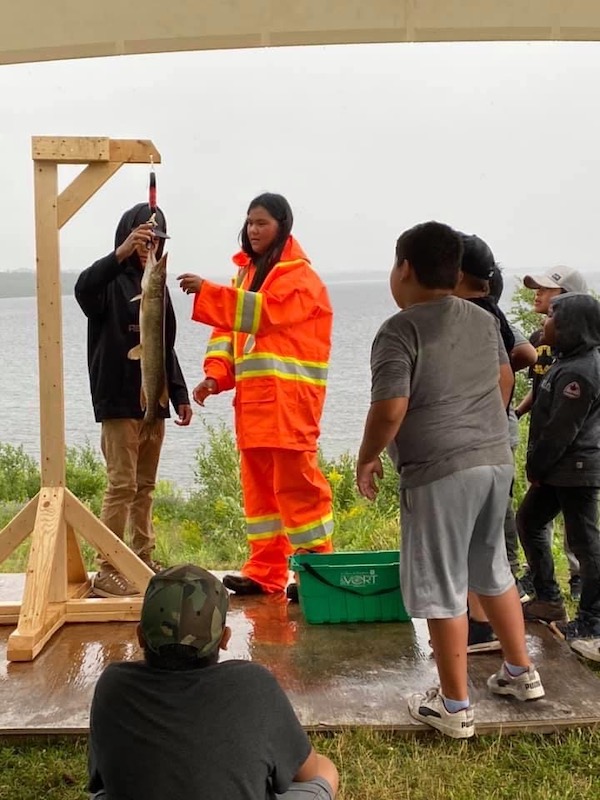Families and friends from all over Eeyou Istchee gathered in Mistissini September 5-6 for the seventh edition of the Big Rock Fishing Derby, organized by the community Sports and Recreation Department.
Team Iywaashtin took the $20,000 first place prize in the walleye category with the help of a seven-pound fish on the first day of the event. The $5,000 first prize in the pike category went to Samuel “Hammer” Mianscum.
The 10 winners in the walleye category were determined by the cumulative weight and length of four fish, two on each day of the event, plus bonus points, while the three winners in the pike category were determined by the single biggest fish of the derby.
The winning four-member Team Iywaashtin was made up of three generations of the Coonishish family from Nemaska: Andy Coonishish, his two sons Shawn and Claude, and granddaughter Jaymie-Lynn.
“She was the first one who brought it up,” said Shawn, Jamie-Lynn’s father. “A couple of weeks prior to the event, she saw that they allowed 16-year-olds, and she wanted to get involved and come fish with us. That’s how it all began.”
While most derbies in the area are open only to participants 18 years and older, the Big Rock derby extended its criteria this year to allow 16- and 17-year-olds, so long as they were accompanied by adults.
For Jaymie-Lynn, who began fishing at age 10, it was her first time fishing on Lake Mistassini.
“Being in the same team as my father, uncle and grandfather was awesome,” she said. “They are very fun to fish with.
“I didn’t expect to be in first place,” she added. “I was pretty shocked.”
Jaymie-Lynn says she hopes other derbies will open their admission criteria to younger participants as well.

“It’s like a family tradition,” said Shawn. “We went out quite often with my father. That’s where me and my brother picked it up, and my daughter too. It’s a good thing for her, because at 16, normally you just want to stay on the phone. It’s good that the younger generation is getting involved.
“I see it as a family event, for friends and people to get together,” he added. “With everything that’s going on with Covid-19, it’s a good way to release some stress. We had a really good time.”
Jaymie-Lynn says she recalls one particularly memorable moment during the competition, when the team caught their biggest fish.
“There was so much excitement,” she said. “My uncle was the one trying to get it in the net. He tried twice, and I never heard my dad swear at someone like he did at my uncle when he missed the fish on the first try.”
Shawn agrees it was a crucial moment that ultimately helped them win the tournament.
“There was a bit of shouting going on,” he said with a laugh. “But [her uncle] got it on the second attempt.”
Registration fees were $600 for a team of up to four participants, and those fees, along with sponsorships, contributed to the more than $50,000 in prizes distributed to the winners and runners-up in the walleye and pike categories.
“The turnout was really good,” said Michel Shecapio, who helped coordinate the event. “We were expecting about 70 teams, and we ended up with 64.”

Organizers made some adjustments to the rules of the derby in order to adapt to Covid-19 security measures, such as allowing only one member of each team at weighing stations, and the introduction of a bonus point system to encourage people to bring in their fish earlier in the day.
“In previous years, at the last hour, the weighing station is crowded,” Shecapio said. “When we use the point system, it’s to avoid the crowding at the last hour. So there weren’t that many people weighing their fish after six. Some people were already done fishing at noon.”
Shecapio says the bonus point system also helps conservation efforts, by encouraging participants to not keep fish in their live wells all day.
Other conservation rules in effect during the competition included requirements to release any fish under 18 inches, and for fish to be confirmed as still alive after being released in order to be counted to a team’s point total.
Asked what the family secret is for catching the biggest fish, Shawn Coonishish emphasizes keeping things simple.
“You can use all kinds of lures, there’s so many out there,” he said. “You just have to be at the right spot at the right time.”






